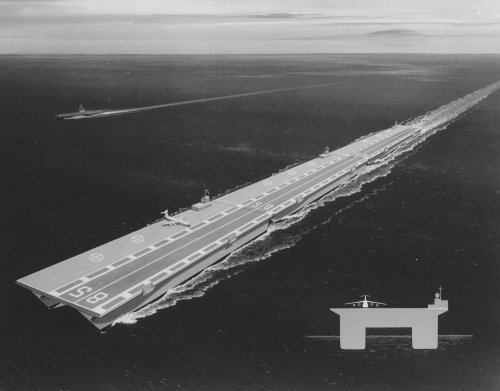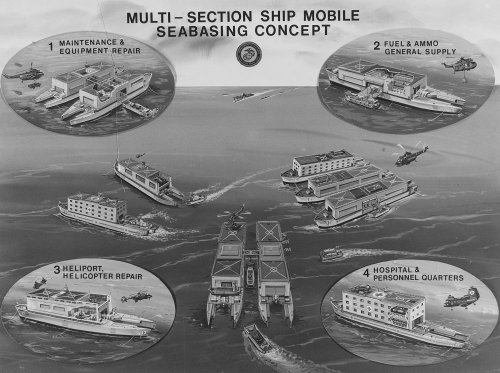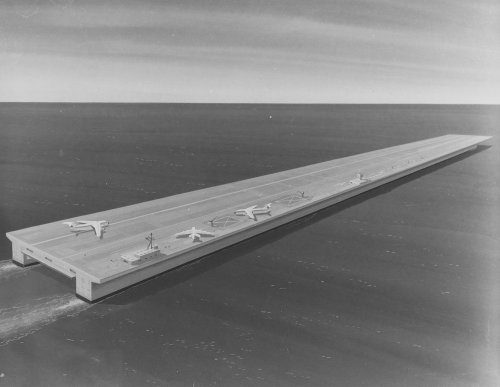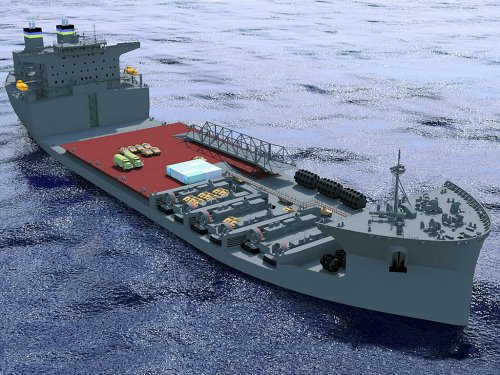You are using an out of date browser. It may not display this or other websites correctly.
You should upgrade or use an alternative browser.
You should upgrade or use an alternative browser.
US Navy/USMC/US Army Sea Basing Concepts
- Thread starter RyanC
- Start date
Charles Gray
ACCESS: Restricted
- Joined
- 13 October 2007
- Messages
- 36
- Reaction score
- 3
How are you supposed to defend those things? They probably have the stealth qualities of the death star and given the profusion of anti-ship missiles, SSK style subs and even ballestic anti-ship missiles, they seem a bit..vulnerable.
- Joined
- 13 August 2007
- Messages
- 8,451
- Reaction score
- 11,017
MoB is BIG
flightdeck is 6660 ft (2096,7 meter) long and 592 ft (180,5 meter) wide
as reverence frist picture with the Lockheed C5-A on the deck.
it remind me of 1930s concepts of artificial island for transcontinental fights
flightdeck is 6660 ft (2096,7 meter) long and 592 ft (180,5 meter) wide
as reverence frist picture with the Lockheed C5-A on the deck.
it remind me of 1930s concepts of artificial island for transcontinental fights
- Joined
- 16 April 2008
- Messages
- 9,606
- Reaction score
- 14,502
Charles Gray said:How are you supposed to defend those things? They probably have the stealth qualities of the death star and given the profusion of anti-ship missiles, SSK style subs and even ballestic anti-ship missiles, they seem a bit..vulnerable.
No worse than defending a fixed port on shore; probably less, given that it can move at least a little. Even a few knots is enough to throw off time-late targeting data for missiles and force subs to work much harder to get into position.
phil gollin
ACCESS: Secret
- Joined
- 19 September 2007
- Messages
- 243
- Reaction score
- 89
What I have never understood with these giant proposals is whether the hull is "rigid" in which case it is going to be dreadfully vulnerable to under-keel explosions, or "flexible" or even "jointed" in which case continuity of services (even hangards) is going to be difficult.
.
.
- Joined
- 12 July 2008
- Messages
- 394
- Reaction score
- 148
The the torpedo threat to a sea base is currently expected to be handled by a combination of rapidly deployable SOSUS like sensors linked to CAPTOR like mine, as well as hard kill anti torpedo defenses. One of the missions of LCS is supposed to be deploying these defenses, a long with submarines like the Ohio SSGNs which could covertly install equipment ahead of the bases movement.
Stuff like that could not work back in the 1960s and 70s when sea basing was first suggested, which is one of many reasons why the idea was not adapted. It is being made to work today for future sea bases. The USN may cease building most types of conventional sea lift and amphibious ships in the near future in favor of sea base ships that do both roles. Concepts for giant floating platforms don't seem to have ever carried much weight because they are just too slow. Most of those big mobile oil drilling rigs, floating cranes and the Sea Bases X-band radar can only make 7-8 knots in the open sea.
Stuff like that could not work back in the 1960s and 70s when sea basing was first suggested, which is one of many reasons why the idea was not adapted. It is being made to work today for future sea bases. The USN may cease building most types of conventional sea lift and amphibious ships in the near future in favor of sea base ships that do both roles. Concepts for giant floating platforms don't seem to have ever carried much weight because they are just too slow. Most of those big mobile oil drilling rigs, floating cranes and the Sea Bases X-band radar can only make 7-8 knots in the open sea.
Colonial-Marine
UAVs are now friend, drones are the real enemy.
- Joined
- 5 October 2009
- Messages
- 1,472
- Reaction score
- 1,324
TomS said:No worse than defending a fixed port on shore; probably less, given that it can move at least a little. Even a few knots is enough to throw off time-late targeting data for missiles and force subs to work much harder to get into position.
Yeah, but despite what a certain US Congressman thinks, islands can't sink and capsize.
Sea Skimmer, how would these sea base ships be different from current dseigns? Some sort of multi-role possibly modular LHD type vessel?
RyanCrierie said:Fun. I liek the C-5A for scale. Clearly we need a folding wing C-5C to fit below decks. ;D
Do you have a link to the above information? If so, please share. Thanks.
XP67_Moonbat
ACCESS: Top Secret
- Joined
- 16 January 2008
- Messages
- 2,271
- Reaction score
- 544
Sea Skimmer said:Concepts for giant floating platforms don't seem to have ever carried much weight because they are just too slow. Most of those big mobile oil drilling rigs, floating cranes and the Sea Bases X-band radar can only make 7-8 knots in the open sea.
Of course, this assumes some if not all major modules do not have a nuclear reactor for power/propulsion. Considering the value of the base when fully assembled, it would probably behoove people to increase both transit speed and reduce logistics(fuel/power) for base operation. Considering the aviation focus, you would want to commit as much onboard fuel storage to aircraft as you could get away with. While something like a single power barge/module is the simple solution, it may not necessarily be the best.
I suppose it's also question of whether the typical MoB is a 3 to 5 megablock module strip operated as a single entity, or if you start going to small module size and increasing the module number. There is also the possibility of different sized blocks/modules as well, perhaps a minimum block size, and a 4x quadruple block sized module, maybe going up 9x nonuple. The quadruple or nonuple size would be ideal for hangars and other large contiguous space needs. An example configuration could be 12 base blocks long and 4 wide, consisting of a core strip of 6 quadruple size blocks flanked by 12 base blocks on each side, to give the impression of a typical 3 megablock MoB while being reconfigurable (such as substituting pairs of edge blocks to make up for quadruple blocks that must be abandoned due to damage to repair flight deck length or to simply make the core strip flight deck even longer)
- Joined
- 12 July 2008
- Messages
- 394
- Reaction score
- 148
Colonial-Marine said:Sea Skimmer, how would these sea base ships be different from current dseigns? Some sort of multi-role possibly modular LHD type vessel?
The studies basically show ships that are like current MPF ships in size and cargo capacity, but with an LHD style deck on top and a hanger built into the superstructure. Basically the idea is to merge the MPF ships and big deck amphibs together so that the MPF cargo can be more easily delivered without docking at an established port. Just look at the recent earthquake disaster in Haiti for the trouble that can cause.
ouroboros said:Of course, this assumes some if not all major modules do not have a nuclear reactor for power/propulsion. Considering the value of the base when fully assembled, it would probably behoove people to increase both transit speed and reduce logistics(fuel/power) for base operation. Considering the aviation focus, you would want to commit as much onboard fuel storage to aircraft as you could get away with. While something like a single power barge/module is the simple solution, it may not necessarily be the best.
Nuclear power doesn't make much sense on ships that would normally sit at anchor most of the year like the MPF vessels do, and anyway simply changing the power source doesn't change anything about how fast the platform can move. You would need Nimitz scale reactors costing billions of dollars and taking up a huge amount of internal space to move platforms like that quickly, because the shape is poor and they are simply very massive hundreds of thousands of ton vessels. You would also create all kinds of new anti nuclear political problems as part of a concept, sea basing, which is supposed to reduce political complications by reducing but not eliminating our need for forward land bases. Freighter-amphibious ship designs can move quickly enough to avoid diesel submarines without being excessively costly. A five thousand foot long 25 knot nuclear powered aircraft carrier oil platform isn't happening in anything even close to modern budget realities.
I suppose it's also question of whether the typical MoB is a 3 to 5 megablock module strip operated as a single entity, or if you start going to small module size and increasing the module number. There is also the possibility of different sized blocks/modules as well, perhaps a minimum block size, and a 4x quadruple block sized module, maybe going up 9x nonuple. The quadruple or nonuple size would be ideal for hangars and other large contiguous space needs. An example configuration could be 12 base blocks long and 4 wide, consisting of a core strip of 6 quadruple size blocks flanked by 12 base blocks on each side, to give the impression of a typical 3 megablock MoB while being reconfigurable (such as substituting pairs of edge blocks to make up for quadruple blocks that must be abandoned due to damage to repair flight deck length or to simply make the core strip flight deck even longer)
More blocks will mean much higher total cost and less stability in rough seas. That's why they want three huge blocks. That way the runway is only moving three ways... which is bad enough. Can you imagine how harsh and dangerous it would be to land a C-17 or even a C-130 on a runway which is moving five or six or more ways?
The military does still see a need to get a lot of cargo forward to the sea base quickly, and that is the job of the Joint High Speed Vessel catamarans. Several of those ships have been bought or being built for the US Navy as we speak. So is one Mobile Landing Platform Ship which will carry hovercraft and act as a floating dock for sea base ships.
i have found two interesting articles about these:
http://www.informationdissemination.net/2007/08/seabasing-fixed-wing-transport-and-ship.html
http://www.alphabetics.info/international/?tag=sea-bases-warfare-high-seas
http://www.informationdissemination.net/2007/08/seabasing-fixed-wing-transport-and-ship.html
http://www.alphabetics.info/international/?tag=sea-bases-warfare-high-seas
Sea Skimmer said:ouroboros said:I suppose it's also question of whether the typical MoB is a 3 to 5 megablock module strip operated as a single entity, or if you start going to small module size and increasing the module number. There is also the possibility of different sized blocks/modules as well, perhaps a minimum block size, and a 4x quadruple block sized module, maybe going up 9x nonuple. The quadruple or nonuple size would be ideal for hangars and other large contiguous space needs. An example configuration could be 12 base blocks long and 4 wide, consisting of a core strip of 6 quadruple size blocks flanked by 12 base blocks on each side, to give the impression of a typical 3 megablock MoB while being reconfigurable (such as substituting pairs of edge blocks to make up for quadruple blocks that must be abandoned due to damage to repair flight deck length or to simply make the core strip flight deck even longer)
More blocks will mean much higher total cost and less stability in rough seas. That's why they want three huge blocks. That way the runway is only moving three ways... which is bad enough. Can you imagine how harsh and dangerous it would be to land a C-17 or even a C-130 on a runway which is moving five or six or more ways?
Most of the proposals show during flight deck operations (and sometimes transit) either direct fixed linkages so the combined structure is monolithic, or use a flight deck edge transverse linkage/hinge, which would restrict movement to a single pitch axis per linkage traverse line. Admittedly, that would result in a worst case of a variably humped runway if the sea state and wave period were unfavorable. All other undesirable flight deck movements are common with existing aircraft carriers (transverse slide, yaw, vertical translation, pitch, roll), though to a certain extent that could be managed via ballasting of the semisubmersible pontoon and extant dynamic positioning thrusters.
While increased block count implies a higher component cost for the complete solution, the MoB is fundamentally designed in a modular fashion from the outset, and taking advantage of economies of scale (production run) rather than economies of scale (size) I would argue the solution cost would actually go down by increasing the number of common components in total rather than as a percentage.
Though the design could end up being substantially different if it wasn't fully intended to hold most of the equipment ahead of time. Megafloat demonstrated (in protected waters at least) that a raw airstrip is feasible with what many would consider a minimal structure. One could easily imagine a heavy lift ship carrying stacks of Megafloat modules as a quick deployment airstrip and as a transfer point for SeaBase assets, where other shore connector options such as LCACS can roll up and collect cargo easily.
- Joined
- 9 October 2009
- Messages
- 21,976
- Reaction score
- 13,637
ouroboros said:Most of the proposals show during flight deck operations (and sometimes transit) either direct fixed linkages so the combined structure is monolithic, or use a flight deck edge transverse linkage/hinge, which would restrict movement to a single pitch axis per linkage traverse line. Admittedly, that would result in a worst case of a variably humped runway if the sea state and wave period were unfavorable. All other undesirable flight deck movements are common with existing aircraft carriers (transverse slide, yaw, vertical translation, pitch, roll), though to a certain extent that could be managed via ballasting of the semisubmersible pontoon and extant dynamic positioning thrusters.
While increased block count implies a higher component cost for the complete solution, the MoB is fundamentally designed in a modular fashion from the outset, and taking advantage of economies of scale (production run) rather than economies of scale (size) I would argue the solution cost would actually go down by increasing the number of common components in total rather than as a percentage.
Though the design could end up being substantially different if it wasn't fully intended to hold most of the equipment ahead of time. Megafloat demonstrated (in protected waters at least) that a raw airstrip is feasible with what many would consider a minimal structure. One could easily imagine a heavy lift ship carrying stacks of Megafloat modules as a quick deployment airstrip and as a transfer point for SeaBase assets, where other shore connector options such as LCACS can roll up and collect cargo easily.
Speaking of hinge ships, an old article on the subject: http://www.americanshipbuilders.com/bulkhead/can-hinge-ship-work-207190
- Joined
- 9 October 2009
- Messages
- 21,976
- Reaction score
- 13,637
A NSWC Carderock Division technical report from 2009 on the Advanced Expeditionary Support Concept Vessel.
ABSTRACT
For decades the United States has used small landing craft in combination with heavy-tonnage
offshore ships to land mobile units of soldiers and armor support on foreign soil. This proven
strategy has led to a current logistics concept known as seabasing, in which equipment and
personnel are transported from an offshore base to shore. The U.S. Navy and Marine Corps now
seek to improve the transport of equipment and logistical support through the use of a flexible
transport ship capable of moving equipment from the continental United States (CONUS) to the
seabase, and then from seabase to shore. The goal of the Advanced Expeditionary Support Vessel
(AESV) concept is to create a potential design for a multi-mission capable vessel that can
travel from CONUS to seabase and to shoreline under a variety of load and mission conditions.
9.1. Design Summary
The final AEV design is a trimaran hullform that has the following characteristics and
capabilities:
• Overall length and width: 181 m x 48.8 m
• 10,700 MT displacement
• 5,000 nm Range at 24 kts
• 1360 Passenger Seats
• Carries 1/5 of MEB
• 1200 sq m of Cargo/Flex Space
• Operates in SS 4
• Unloads using an inflatable causeway
• Multi-mission capable
Though it cannot move an entire MEB in one trip, the design team feels that the design is
a significant improvement over the current ship-to-shore connectors used today. The ship is both
robust and flexible in its cargo carrying and beaching capabilities, and fulfills the requirements
laid out for it at the beginning of the design process.
- Joined
- 9 October 2009
- Messages
- 21,976
- Reaction score
- 13,637
A Carderock Division Technical Report from 2004 titled 'Use of Seaplanes and Integration within a Sea Base'.
- Joined
- 9 October 2009
- Messages
- 21,976
- Reaction score
- 13,637
- Joined
- 9 October 2009
- Messages
- 21,976
- Reaction score
- 13,637
http://www.dtic.mil/dtic/tr/fulltext/u2/a525958.pdf
Grey Havoc said:A Carderock Division Technical Report from 2004 titled 'Use of Seaplanes and Integration within a Sea Base'.
For those who have read this article, I give you....HMS Flat Iron
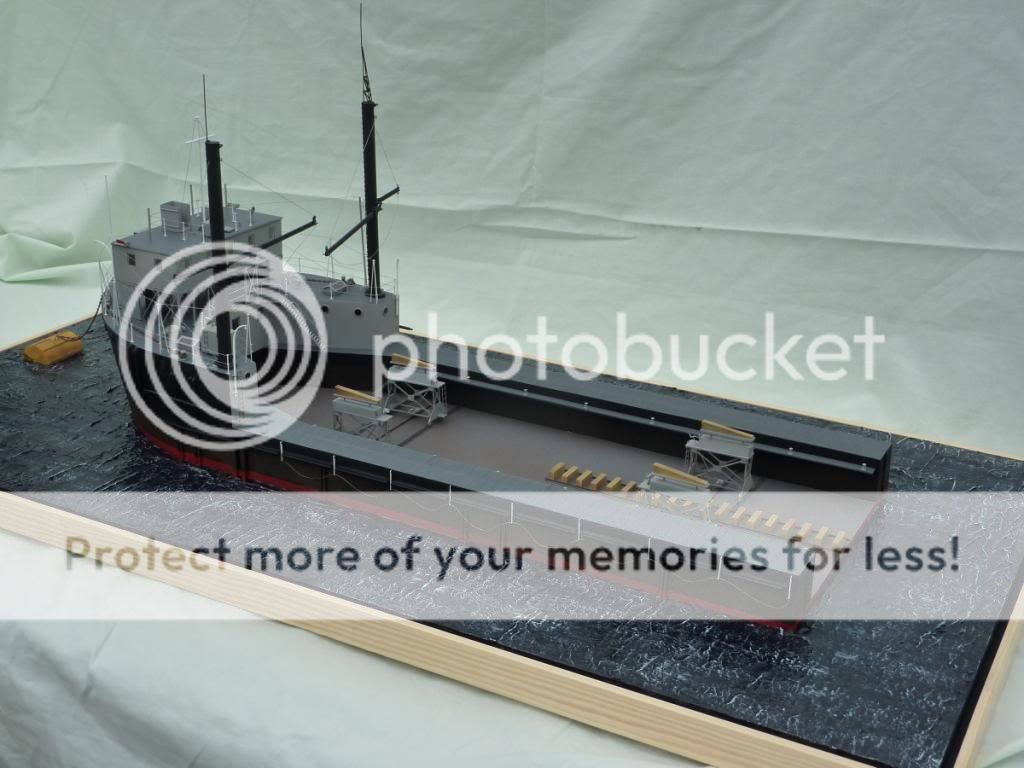
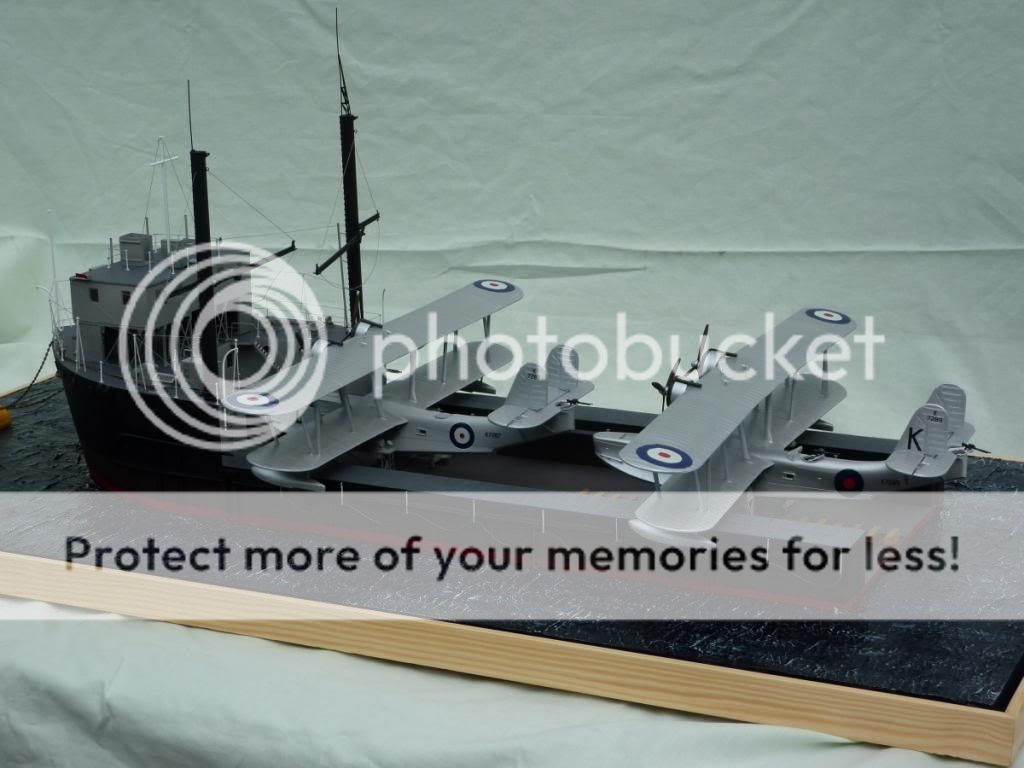
From a posting on the World naval Ships Forum
Looking through "The Royal Navy in Focus 1920-29" published by Maritime Books there was a photo of a “Seaplane Docking Lighter" 1928 with the caption making the comment that she flies the RAF ensign and reminding that the Admiralty didn’t gain control of the FAA until 1937.
The seaplane docking lighter is not a floating dock in the conventional configuration but is ship shaped with a short forecastle, bridge type accommodation structure and a long low well deck which allowed the aircraft wings clearance - it was a non-powered dumb vessel. Its tonnage was 1000 tons gross & 400 net. When ballasted down, it could accommodate craft up to 7ft draught.
It could lift up to two seaplanes at a time and was designed by Mr JN Narbeth who was Assistant Director of Naval Construction and was intended to allow seaplanes to be maintained at bases where there were no slipways to haul them out. It was towed and then anchored at location. The crew of 19 apparently referred to it as" HMS Flat Iron".
So far I have found reference to it at Portland 1928, Sullum Voe 1932, Pembroke Dock 1932-38 and Invergordon 1938. There is also a reference to a "docking barge" at Miekle Ferry (which I think is on the Dornoch Firth) in 1944 after that don't know.
There is a picture in the Muckleburgh Collection in Norfolk which shows the vessel with an RAF launch on a cradle inside the dock instead of a seaplane.
- Joined
- 9 October 2009
- Messages
- 21,976
- Reaction score
- 13,637
Interesting. Good find!
On another note, here's a link to the old Heavy Air Landing Seabase Ship thread.
On another note, here's a link to the old Heavy Air Landing Seabase Ship thread.
- Joined
- 9 October 2009
- Messages
- 21,976
- Reaction score
- 13,637
EXPEDITIONARY LOGISTIC FACILITY
A CONCEPTUAL DESIGN OF MATERIALS
HANDLING SYSTEM FOR NAVAL
ADVANCED BASE PORTS
NAVAL CIVIL ENGINEERING LABORATORY (1971)
A CONCEPTUAL DESIGN OF MATERIALS
HANDLING SYSTEM FOR NAVAL
ADVANCED BASE PORTS
NAVAL CIVIL ENGINEERING LABORATORY (1971)
- Joined
- 9 October 2009
- Messages
- 21,976
- Reaction score
- 13,637
SEABASING INNOVATION CELL ‘TRANSFER OF GOODS AT SEA’
FINAL REPORT
Naval Surface Warfare Center
Carderock Division
FINAL REPORT
Naval Surface Warfare Center
Carderock Division
- Joined
- 9 October 2009
- Messages
- 21,976
- Reaction score
- 13,637
http://snafu-solomon.blogspot.ie/2014/02/sea-basing-report.html
ford_tempo
ACCESS: Confidential
- Joined
- 31 January 2011
- Messages
- 78
- Reaction score
- 9
I attach an academic paper about MOB concepts. While it is technical it also presents a less technical description of a study by Aker: I also have another paper like that but it exceeds the limit, so I just report the link for this one:
http://link.springer.com/article/10.1007%2FBF02489808
the concepts described in that one are by Brown and Root and McDermott
Part of the material is already contained in other reports presented in this site but one I guess is new. It is a study by Aker for a single 800 meters module, barge type MOB made of concrete where the required length is obtained via two cantilevered deck extensions. What I find interesting in this proposal is the claim that with 173 MW of power it could reach 12knots. Shouldn't that be enough to operate C-130 with an 800 meter long runaway? if that's true even with just one module and no deck extensions it could work as a MOB.
I think a book that describes the evolution of the seabase and MOB options would be very interesting and by now there must be enough material to write one, but perhaps Friedman's book on US amphibious ships (unforutately out of print) already does the job.
best
F_T
http://link.springer.com/article/10.1007%2FBF02489808
the concepts described in that one are by Brown and Root and McDermott
Part of the material is already contained in other reports presented in this site but one I guess is new. It is a study by Aker for a single 800 meters module, barge type MOB made of concrete where the required length is obtained via two cantilevered deck extensions. What I find interesting in this proposal is the claim that with 173 MW of power it could reach 12knots. Shouldn't that be enough to operate C-130 with an 800 meter long runaway? if that's true even with just one module and no deck extensions it could work as a MOB.
I think a book that describes the evolution of the seabase and MOB options would be very interesting and by now there must be enough material to write one, but perhaps Friedman's book on US amphibious ships (unforutately out of print) already does the job.
best
F_T
Attachments
jsport
what do you know about surfing Major? you're from-
- Joined
- 27 July 2011
- Messages
- 7,732
- Reaction score
- 5,751
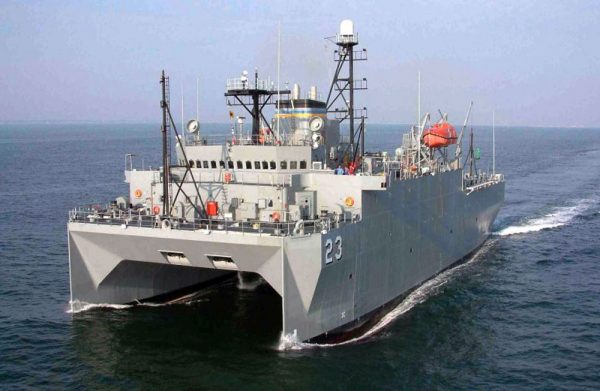
US Navy Begins Design Evaluation for New Sub-Tracking Ships
The new ocean surveillance ships are expected to begin entering the fleet in 2025.
thediplomat.com
- Joined
- 16 April 2008
- Messages
- 9,606
- Reaction score
- 14,502

US Navy Begins Design Evaluation for New Sub-Tracking Ships
The new ocean surveillance ships are expected to begin entering the fleet in 2025.thediplomat.com
T-AGOS/SURTASS has nothing to do with sea-basing.
jsport
what do you know about surfing Major? you're from-
- Joined
- 27 July 2011
- Messages
- 7,732
- Reaction score
- 5,751
An impervious MOB would need enough Marines, Air Force and Army assets to attain theater dominance since the strategic sealift seems to be non strategy so far. A MOB would need Vertical Gun Systems (VGSs) of sufficient size and barrel numbers, enough large, deep magazine PBWs and other large DEWs as well as enough:
US Navy Begins Design Evaluation for New Sub-Tracking Ships
The new ocean surveillance ships are expected to begin entering the fleet in 2025.thediplomat.com
T-AGOS/SURTASS has nothing to do with sea-basing.
1. hypersonic land attack and sea attack missiles
2. anti-TBMs
3. anti-cruise missiles
4. SAMs
5. anti-hypersonics
6. anti-ship missiles
to dominate a theater.
As many single mission focused T-AGOS/SURTASS are needed to assure adversary submarines are never even close to the MOB.
- Joined
- 16 April 2008
- Messages
- 9,606
- Reaction score
- 14,502
This is just stringing words together without understanding anything about how these things all work.
SURTASS isn't related to sea-basing at all. As you can tell by the fact that they are looking at the SURTASS despite the fact that sea-basing pretty much isn't happening.
SURTASS isn't related to sea-basing at all. As you can tell by the fact that they are looking at the SURTASS despite the fact that sea-basing pretty much isn't happening.
ReprobateJoeshmoe
ACCESS: Restricted
- Joined
- 8 September 2020
- Messages
- 41
- Reaction score
- 18
I would appreciate if you would explain what surtass is, and why seabasing is not happening. Is the military not fully invested in it. Do they think it is disadvantaged. Just a friendly person asking who ha little knowledge on these topics.This is just stringing words together without understanding anything about how these things all work.
SURTASS isn't related to sea-basing at all. As you can tell by the fact that they are looking at the SURTASS despite the fact that sea-basing pretty much isn't happening.
- Joined
- 16 April 2008
- Messages
- 9,606
- Reaction score
- 14,502
SURTASS stands for Surveillance Towed Array Sensor System. It's basically a very large, very sensitive version of the towed active and passive sonars used on warships. It's designed to detect submarines at very long ranges to cue ASW hunter-killer forces on to them before they can threaten friendly forces.
Sea basing in the sense of large mobile offshore structures that can replace bases ashore just isn't happening because they are technically difficult, very expensive, and limited in capacity compared to traditional land bases.
Sea basing in the sense of large mobile offshore structures that can replace bases ashore just isn't happening because they are technically difficult, very expensive, and limited in capacity compared to traditional land bases.
jsport
what do you know about surfing Major? you're from-
- Joined
- 27 July 2011
- Messages
- 7,732
- Reaction score
- 5,751
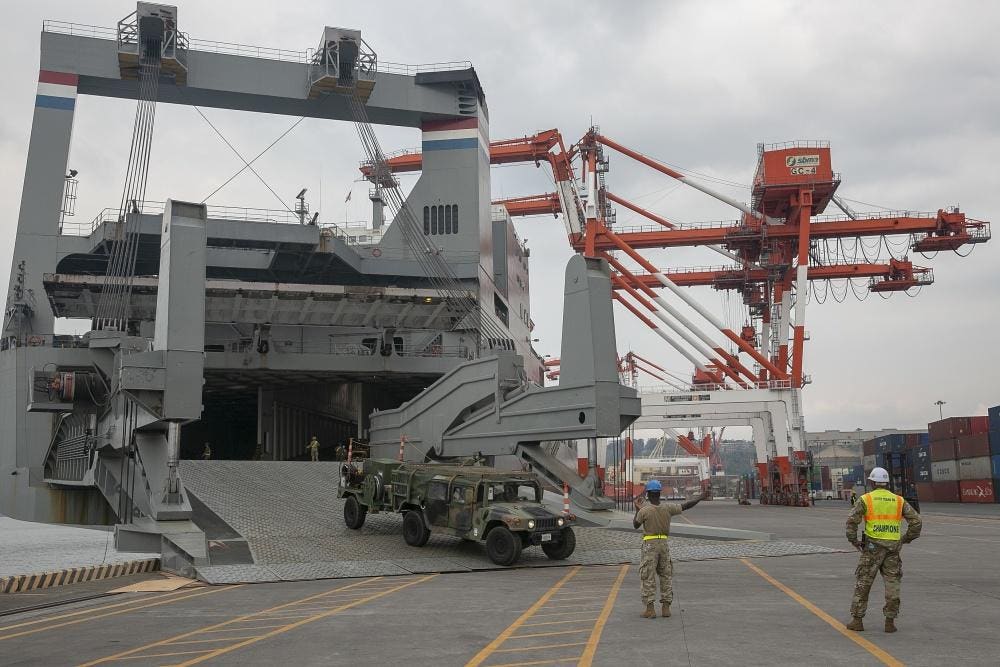
Will The Pentagon’s Bold Battle Force 2045 Plan Finally Fix Sealift?
Whatever happens to Esper's grand plan for the Navy, sealift is an eminently fixable challenge.
 www.forbes.com
www.forbes.com
jsport
what do you know about surfing Major? you're from-
- Joined
- 27 July 2011
- Messages
- 7,732
- Reaction score
- 5,751

Expeditionary sea base Miguel Keith commissioned by Navy
The ship is named for Marine Corps Lance Cpl. Miguel Keith, who was posthumously awarded the Medal of Honor for his actions during the Vietnam War.
- Joined
- 9 October 2009
- Messages
- 21,976
- Reaction score
- 13,637
jsport
what do you know about surfing Major? you're from-
- Joined
- 27 July 2011
- Messages
- 7,732
- Reaction score
- 5,751
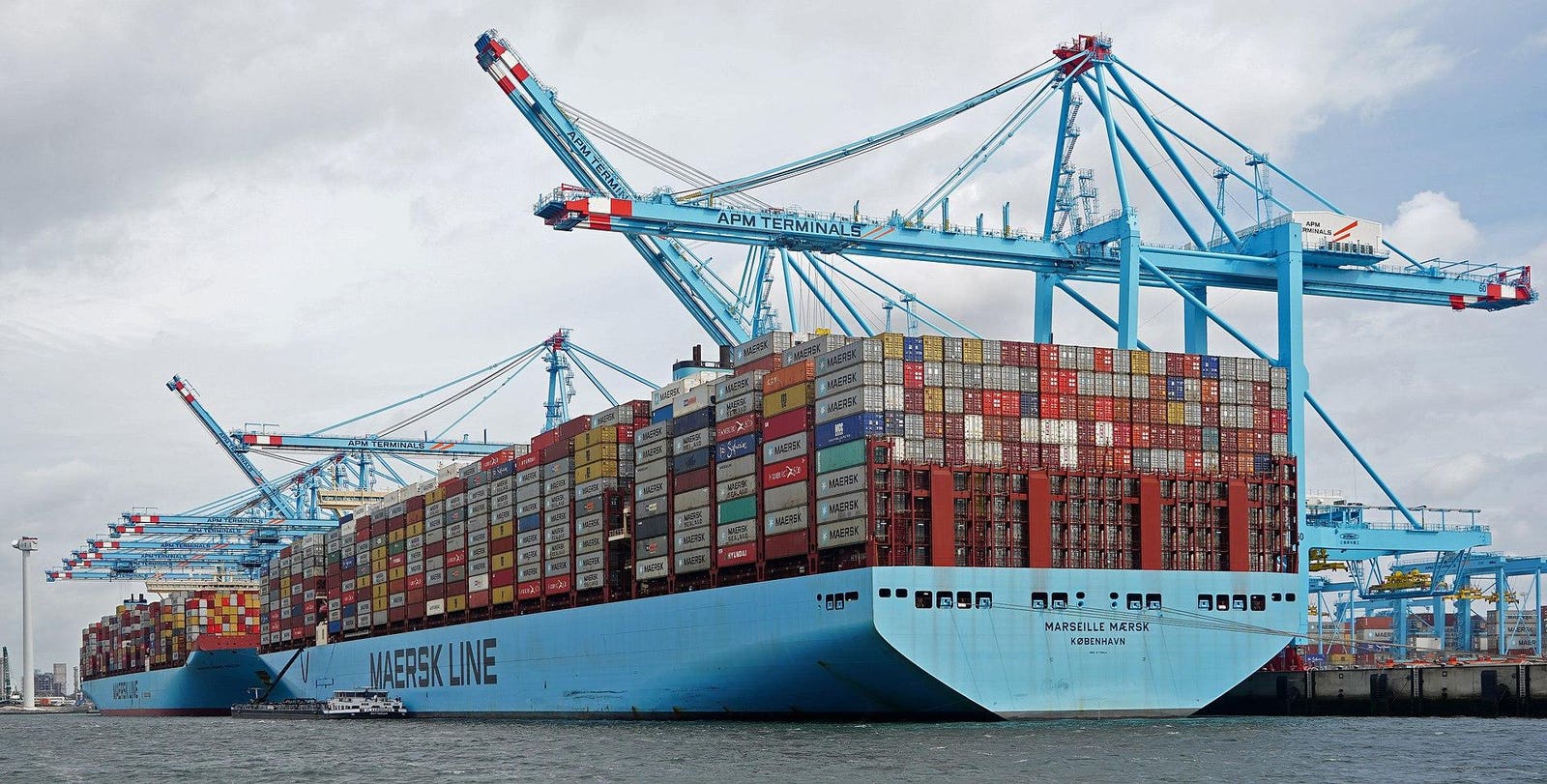
Expanded Cargo Preferences May Be The Easiest Way To Rebuild The U.S. Maritime Industry
Mandating broader use cargo preferences in U.S. trade would cost Washington nothing while rebuilding a strategic industry.
 www.forbes.com
www.forbes.com
- Joined
- 9 October 2009
- Messages
- 21,976
- Reaction score
- 13,637
Seaplane Economics: A quantitative cost comparison of seaplanes and landplanes for Sea Base operations (2007)
Naval Surface Warfare Center
Carderock Division
Naval Surface Warfare Center
Carderock Division
Similar threads
-
-
-
Sea-based Anti-Ballastic Missile Intercept System (SABMIS)
- Started by Triton
- Replies: 69
-
-

